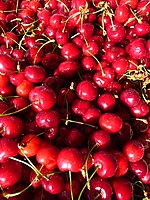
Photo from wikipedia
This study focused on the identification (by LC-PDA-qTof-ESI-MS) and quantification (by UPLC-PDA) of isoprenoids of the fruit tree leaves (FTL) of commonly consumed fruits: apple, pears, quince, apricot, peach, plums,… Click to show full abstract
This study focused on the identification (by LC-PDA-qTof-ESI-MS) and quantification (by UPLC-PDA) of isoprenoids of the fruit tree leaves (FTL) of commonly consumed fruits: apple, pears, quince, apricot, peach, plums, sweet and sour cherry. The FTL were collected at 2 time points: after tree blooming and after fruit collection. In FTL 7 carotenoids and 16 chlorophylls were identified, but the number of labeled chlorophyll compounds depended on the species. FTL of apple, sour cherry and apricot were identified as the best sources of chlorophylls (mean 404.8, 388.7 and 364.5 mg/100 g dw, respectively) and sweet and sour cherry leaves as the best sources of carotenoids (831.4 and 1162.0 mg/100 g dw, respectively). A lower content of chlorophylls and carotenoids, but not significantly, was detected in leaves after autumn collection of fruits compared to leaves collected after blooming. Fruit tree leaves are good material for isolation of chlorophylls and carotenoids for application in cosmetics, pharmaceuticals or in the food industry, e.g. production of beverages or puree.
Journal Title: Food chemistry
Year Published: 2021
Link to full text (if available)
Share on Social Media: Sign Up to like & get
recommendations!